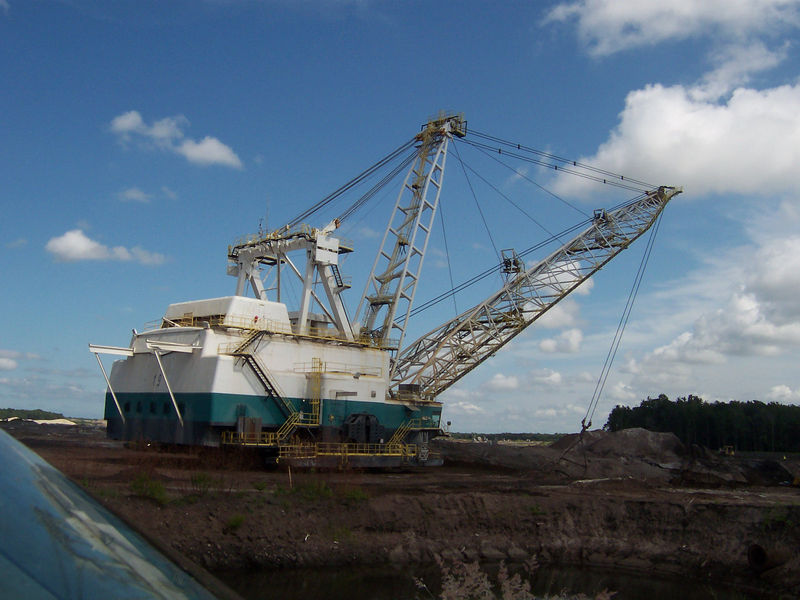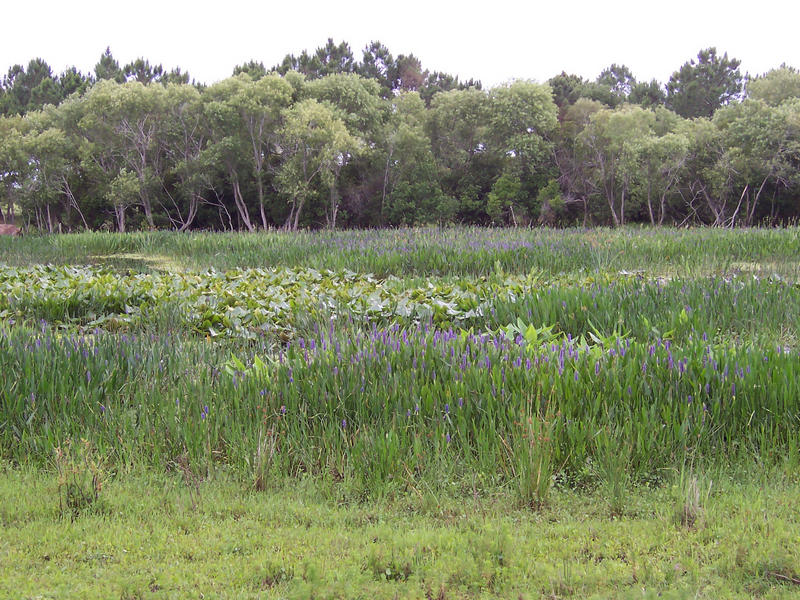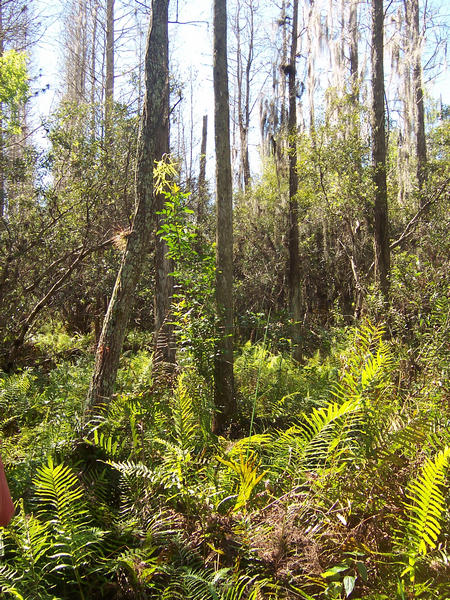Florida's Phosphate Mines
There are 27 phosphate mines in Florida, covering more than 450,000 acres. Nine phosphate mines are currently active. Nine mines are 100 percent reclaimed and released from reclamation obligations. The remaining mines are either not started or are shut down. Phosphate mines typically range in size from approximately 5,000 to 100,000 acres.
Phosphate mining disturbs between 3,000 to 6,000 acres annually in Florida. Approximately 25-30% of these lands are wetlands or other surface waters.
The Mining and Mitigation program administers reclamation, environmental resource/stormwater management, and federally-delegated dredge and fill (404) permit programs for mining operations in Florida, including phosphate. Reclamation standards for phosphate mining are detailed in Part II of Chapter 211, Part II of Chapter 378, Florida Statutes (F.S.) and Chapter 62C-16, Florida Administrative Code (F.A.C.).
Phosphate mines require an ERP unless they are specifically grandfathered under Chapter 373.414(15), F.S. Projects associated with mining operations for phosphate on land that was included in a conceptual reclamation plan or modification submitted prior to July 1, 1996, are grandfathered from the ERP rules. Even if grandfathered from ERP, unless the activity is specifically exempted by statutes or rules, a Wetland Resource Permit (WRP) is required if the project involves dredging or filling conducted in, on or over wetlands or other surface waters of the state. For phosphate mines still qualified for a WRP, the applicable rule is Chapter 62-312, F.A.C., effective Aug. 7, 1995. Environmental resource permitting standards are detailed in Part IV of Chapter 373, F.S., and Chapter 62-330, F.A.C.
What is phosphate?
Phosphate includes several naturally occurring minerals that contain phosphorus as well as other elements. It is primarily used to produce fertilizers for food production. It may also be used in animal feed supplements, food preservatives and many industrial products.
Where is phosphate mined in Florida?
Phosphate mining began in Florida in 1883 near Hawthorne in Alachua County. This hard-rock phosphate was mined in a region extending from Alachua to Citrus counties. The mining of pebble phosphate began in 1888 in central Florida and in the 1960s in Hamilton County.
Today phosphate mining occurs primarily in the central Florida area (Polk, Hillsborough, Manatee and Hardee counties). The central Florida phosphate mining region covers approximately 1.3 million acres of land known as the “Bone Valley.” There is one phosphate mine operating in North Florida (Hamilton County). Click for full-page map of Phosphate Mine Boundaries.
How is phosphate mined in Florida?
Various activities are undertaken prior to mining phosphate. These include performing wildlife surveys and relocating threatened and endangered species, clearing the land, using best management practices and other measures to protect areas that will not be mined, and putting systems in place to offset impacts to water levels and flow in surrounding areas.
Following clearing and site preparation, large draglines are used to conduct the mining. The dragline bucket holds from 45 to 65 cubic yards of material and is large enough to hold a truck or van. It scoops up the top 15 to 30 feet of earth, known as overburden, and dumps it in spoil piles to the side of the mine pit. The dragline then digs out the ore-bearing layer (known as the matrix), which consists of about equal parts phosphate rock, clay and sand.
Matrix material is then dumped in a pit where high-pressure water guns create a slurry that can then be pumped to the beneficiation plant, which can be several miles away. At the beneficiation plant, the phosphate is separated from the sand and clay.
The phosphate is sent by rail to a separate chemical processing plant where it is processed for use in fertilizer and other products. The chemical processing is done at separate facilities that are not regulated by the Mining and Mitigation Program. After going through beneficiation, the clay is pumped through pipelines into large impoundment areas, known as clay settling areas, where they will remain. The sand is pumped through pipelines back to the mined area and is used in reclamation.
What are the reclamation standards for phosphate mines?
Prior to 1975, reclamation of mined land was not required. Lands mined prior to July 1, 1975, are called “nonmandatory” land. The Nonmandatory Land Reclamation Program provided funding for the reclamation of eligible phosphate lands mined before July 1975.
The Florida Legislature requires that all lands mined for phosphate after July 1, 1975, be reclaimed. Land mined during or after 1975 that is required to be reclaimed is called “mandatory” land. Phosphate mine operators are required to provide the department with a conceptual reclamation plan. Part of our extensive evaluation of reclamation plan design includes analysis of water quantity and quality impacts, consideration of best available technology, and focusing on the preservation of wildlife habitat and resources.
Reclamation standards for phosphate lands include contouring to safe slopes, providing for acceptable water quality and quantity, revegetation, and the return of wetlands to pre-mining type, nature, function and acreage. Reclamation standards for phosphate lands are detailed in Part II of Chapter 378, F.S., and Chapter 62C-16, F.A.C. The forms used for the reclamation program and filing instructions may be obtained online.
What permits are required for phosphate mines?
There is no comprehensive permit that covers all aspects of large developments, including mines. To start a mine, the applicant may have to consider the requirements of several regulatory agencies. To start construction, the applicant must have all necessary federal, state and local approvals. The Mining and Mitigation Program reviews applications for Environmental Resource Permits (ERP) and Wetland Resource Permits for mines, as well as State 404 permits for mining activities that involve dredging or filling in state-assumed waters.
Phosphate mines that were not included in a conceptual reclamation plan or modification application prior to July 1, 1996, are required to have an Environmental Resource Permit. Activities that typically require an ERP include dredging and filling located in, on or over wetlands or other surface waters, as well as the construction of structures. The permit governs the construction, alteration, operation, maintenance, repair, abandonment and removal of stormwater management systems, including dams, impoundments, reservoirs, appurtenant work and works.
The rules used to implement the ERP are authorized under Chapter 373, F.S. ERP activities are also subject to Chapter 403, F.S., which governs activities that may pollute Florida's ground and surface waters, including wetlands. Chapter 62-330, F.A.C. and the Applicant’s Handbook, Volume I and Applicant’s Handbook, Volume II provide explanations, procedures, guidance, standards and criteria for ERPs.
Phosphate mines that were included in a conceptual reclamation plan or modification application prior to July 1, 1996, are grandfathered from the ERP rules. Even if grandfathered from ERP, unless the activity is specifically exempted by statutes or rules, a Wetland Resource Permit (WRP) is required if the project involves dredging or filling conducted in, on or over wetlands or other surface waters of the state. WRP are issued under Chapter 62-312, F.A.C.
The Mining and Mitigation program does not handle industrial wastewater permitting for phosphate. The Phosphate Management Program implements industrial wastewater permitting, compliance and enforcement activities for the phosphate industry. The program regulates the design, construction, operation and maintenance of phosphogypsum stack systems, which are wastewater systems associated with the chemical plants that process phosphate ore into fertilizer products.
Reclamation Reports
The required rate of reclamation is established by statute. The reports provided below summarize the annual rate of reclamation for Florida phosphate mines.
Financial Responsibility Reports
Compliance with the rate of reclamation in Chapter 378, F.S., is deemed to serve as appropriate financial responsibility for reclamation obligations. The reports provided below summarize the status of Financial Responsibility for Florida phosphate mines.
How can you obtain public records?
You can obtain a list of applications for permits and conceptual reclamation plans currently under review within the department. This will provide the application number that can be used when requesting public records.
The Department of Environmental Protection maintains public records in an electronic document management system. You can obtain public records relating to permit applications, conceptual reclamation plans, reports and inspections through either of these two websites:
You may also request public records by contacting the Mining and Mitigation Program at MiningAndMitigation@FloridaDEP.gov or 850-245-8336.
Additional Phosphate-Related Projects
IHN
The Integrated Habitat Network (IHN) is a regional plan that outlines guiding principles for the design of reclamation in the entire Central Florida phosphate-mining district (approximately 1.3 million acres of land). The IHN utilizes a corridor concept to promote reclamation designs that replace drainage and hydrologic functions and provide quality wildlife habitat in optimal locations.
Upper Peace River/Saddle Creek Restoration Project
The Upper Peace River/Saddle Creek Restoration Project has been completed on land historically mined for phosphate. The Mining and Mitigation Program’s Homeland Field Office has partnered with other agencies to restore and manage land in the upper Peace River basin that was mined for phosphate prior to 1975.
Before 1975, reclamation of mined land was not required. The goal of the restoration project was to improve the hydrology and ecology of the site by restoring wetlands. The restored land is being managed for wildlife habitat and recreational use as part of the Tenoroc Fish Management area.
FIPR
The Florida Industrial and Phosphate Research Institute (FIPR Institute) is a legislatively created state research unit within Florida Polytechnic University. Since its inception (as the Florida Institute of Phosphate Research) in 1978, the FIPR Institute has grown and developed into a world-class research entity specializing in phosphate-related issues and industrial applied science and engineering.
For More Information
Florida Department of Environmental Protection
Mining and Mitigation Program
2600 Blair Stone Road, Mail Station 3577
Tallahassee, FL 32399
850-245-8336 (phone) / 850-245-8356 (fax)
MiningAndMitigation@FloridaDEP.gov




